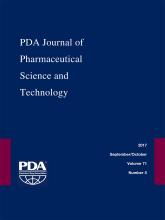Abstract
Geobacillus stearothermophilus spores on stainless steel discs are routinely used as biological indicators for the validation of hydrogen peroxide bio-decontamination processes. Given ongoing concerns about the reliability and response time of biological indicators, we explored the potential for an enzyme-based approach to decontamination process evaluation. Thermostable adenylate kinase enzyme was coated onto a solid support and exposed to hydrogen peroxide vapour, in parallel with standard commercial 6-log biological indicators, during a series of vapour-phase hydrogen peroxide cycles in a flexible film isolator. The exposed biological indicators were enumerated to define the degree of kill at different time intervals and the results compared to the thermostable adenylate kinase values, as determined by measuring adenosine triphosphate produced by residual active enzyme. Both biological indicators and the thermostable adenylate kinase indicators exhibited a biphasic inactivation profile during the process. There was significant variance between individual cycles, with some cycles showing complete inactivation of the biological indicators to the limit of detection of the assay, within 6 min, whereas biological indicators in some cycles were inactivated at a time greater than 12 min. The log-kill of the biological indicators at intermediate time points were plotted and compared to the fully quantifiable measurements derived from the thermostable adenylate kinase indicators at the same time points. The results demonstrated very similar inactivation profiles for the enzyme and for the biological indicators, thus it was possible to define a relationship between relative light units measurement and biological indicator kill. This indicates that it is possible to use thermostable adenylate kinase measurement as a direct measure of vapour-phase hydrogen peroxide bio-decontamination performance, expressed in terms of log reduction. Because thermostable adenylate kinase measurement can be achieved within a few minutes of vapour-phase hydrogen peroxide cycle completion, compared with a minimum of 7 days for the evaluation of biological indicator growth, this offers a potentially valuable tool for rapid vapour-phase hydrogen peroxide bio-decontamination cycle development and subsequent re-qualification.
LAY ABSTRACT: Pharmaceutical product manufacture is performed in controlled cleanroom and closed chamber environments (isolators) to reduce the risk of contamination. These environments undergo regular decontamination to control microbial contamination levels, using a range of methods, one of which is to vaporize hydrogen peroxide (a chemical disinfectant) into a gas or an aerosol and disperse it throughout the environment, killing any microorganisms present. Biological indicators, which consist of a small steel coupon carrying a population of bacterial spores that are more resistant to hydrogen peroxide than are most microorganisms, are placed within the environment, and then tested for growth following treatment to ensure the process was effective. Confirmation of growth/no growth (and therefore hydrogen peroxide cycle efficacy) can take up to 7 days, which significantly increases time and cost of developing and confirming cycle efficacy. This study tests whether a new technology which uses a robust enzyme, thermostable adenylate kinase, could be used to predict biological indicator growth. The study shows this method can be used to confirm hydrogen peroxide cycle efficacy, by predicting whether the BI is killed at a specific time point or not and results are obtained in a few minutes rather than 7 days. This potentially offers significant time and cost benefits.
- Hydrogen peroxide
- Isolator validation
- Decontamination monitoring
- Biological indicator (BI)
- Geobacillus stearothermophilus
- Thermostable adenylate kinase (tAK)
- © PDA, Inc. 2017
PDA members receive access to all articles published in the current year and previous volume year. Institutional subscribers received access to all content. Log in below to receive access to this article if you are either of these.
If you are neither or you are a PDA member trying to access an article outside of your membership license, then you must purchase access to this article (below). If you do not have a username or password for JPST, you will be required to create an account prior to purchasing.
Full issue PDFs are for PDA members only.
Note to pda.org users
The PDA and PDA bookstore websites (www.pda.org and www.pda.org/bookstore) are separate websites from the PDA JPST website. When you first join PDA, your initial UserID and Password are sent to HighWirePress to create your PDA JPST account. Subsequent UserrID and Password changes required at the PDA websites will not pass on to PDA JPST and vice versa. If you forget your PDA JPST UserID and/or Password, you can request help to retrieve UserID and reset Password below.






